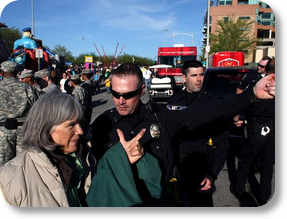
When a teenage mob terrorized Louisville's downtown last March, the startled citizenry demanded more cops to control the heart of their city. The mayor and police chief faced a conundrum.
Shift cops downtown from other parts of the city, or quickly burn through the police department's overtime budget. They chose to spend the money.
Police officers logged more than 25,000 hours in overtime during the six weeks between the March 22 unrest and the Derby. It cost just shy of $1 million, a 40 percent increase in overtime payments from the same stretch of time the year before, according to department records.
Within a month of the mob, the department had busted its $1.9 million budget for unscheduled overtime. By June 30, the end of the fiscal year, the department anticipates being around $1 million over, said Assistant Chief of Police Ozzy Gibson.
The city's Office of Management and Budget will have to figure out where to absorb the extra costs, said city spokesman Chris Poynter. Most, he said, can likely come from unspent money elsewhere in the police department's budget.
The police department believes the money well spent: Thunder Over Louisville on the Waterfront — the site where punches were first thrown on March 22 — ended without incident. The Pegasus Parade, allegedly a target of the teenage gang blamed for the mob, similarly saw no violence.
"Is spending on overtime good? No, it's never great," said Gibson. "But sometimes it's a necessity."
On Thunder Over Louisville this year, officers accumulated 2,103 hours of overtime, worth $83,762. The same event last year required 1,220 hours of overtime, for $45,329. The Pegasus Parade saw a hike of more than 150 percent in overtime expenses, from $16,089 in 2013 to $40,710 in 2014.
The mob had left them with little choice, Gibson said.
"We had to protect the community, we can't take that chance," he said. "You assume the worst and hope for the best."
The violence on March 22 began at the Waterfront, where around 200 teens gathered. At 7 p.m., hordes of kids attacked two men on the Big Four Bridge without provocation. The pack broke into smaller groups, some 50 teens deep, and spread into downtown, robbing, beating, breaking windows, kicking cars and looting stores. Police scrambled to keep up with them, but the groups scattered and reformed, and the crime spree continued for several hours.
Louisville residents were enraged the teens managed to continue for hours unabated. Police Chief Steve Conrad pledged an increased presence downtown, around-the-clock patrols on the Waterfront and additional officers at hotspots downtown.
But the ordeal unleashed a city-wide debate about public safety, and how suited the police department is to keep the city safe.
Conrad believed the 1,211 officers now on the force are sufficient. Some on the Metro Council disagreed, questioned why an adequately staffed department must rely so heavily on overtime and commissioned a study to determine the appropriate number of officers on the streets.
Between March 22 and May 4, officers worked an average of 569 overtime hours each day, up from a daily average of 426 hours during the same stretch in 2013. They patrolled the Waterfront around-the-clock, on foot, on horseback, on bicycles and in cruisers. They manned other downtown hotspots and the Broadway corridor, where groups of kids were known to gather.
The city has since been quiet.
Other public safety measures spawned by the March 22 violence were financed by other city coffers. The 27 crime cameras installed at the Waterfront on the eve of Thunder Over Louisville were paid for with $227,000 from drug seizure revenues.
Mayor Greg Fischer is pushing his budget for the next fiscal year, which includes a $6.7 million increase in public safety spending, and would allow the department to hire 24 additional officers, 15 stationed downtown and another nine in west Louisville, along with civilian employees.
Until they can be hired and trained, the city is bracing for months of steep overtime costs into the next fiscal year.
Gibson compared the increased overtime in the wake of the mob to the millions the city had to spend during this year's unseasonably snowy winter — an unexpected and unavoidable cost of government.
Not all the cost were shouldered by taxpayers, said police department spokeswoman Alicia Smiley. Churchill Downs chips in $225,000 for police overtime every year. And not all of the increase can be blamed on the mob: many officers received a 2 percent pay increase last summer, which slightly raised their hourly wage.
On Oaks day this year, the police department spent just under $113,000 on overtime, up from around $81,000 in 2013. The Derby expenses spiked by more than 40 percent, from $100,125 in 2013 to $142,484 in 2014.
By the Sunday following Derby, the city had spent just under $950,000 on overtime in six week, nearly half the money allotted for the entire year, and a quarter-million more than was spent during the same stretch last year.







